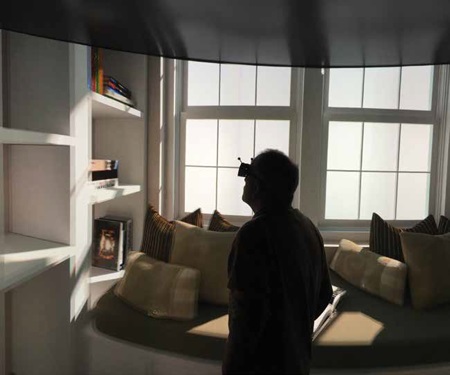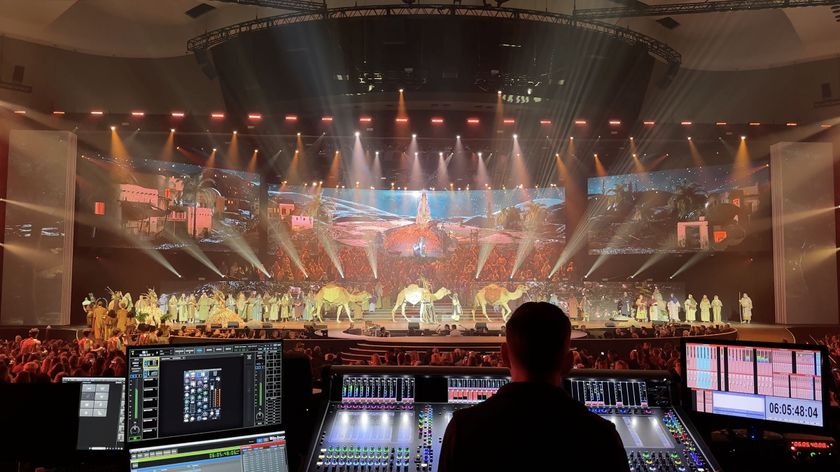When it comes to technologies like augmented reality (AR), virtual reality (VR), gesture recognition technology (acronym optional), and beacons (no acronym necessary), it’s easy to get confused by what they actually are. Depending on the developer, definitions vary, resulting in debates about whether or not Microsoft’s HoloLens technically produces holograms, or if someone’s altered reality is in fact virtual, or just augmented, or maybe mixed. Technological hairsplitting aside, one thing is clear: AV designers and integrators stand to capitalize on this stuff—as long as they understand how it applies to the spaces they’re working with.

YURT––the virtual reality theater/cave at Brown University’s Center for Computation and Visualization, where, using Scalable Display Technologies’ software, 69 HD projectors are edge-blended. “I think from a tech standpoint, these are just more peripherals—they’re just more inputs and more outputs to the systems that we’re already designing, and I think, as such, they don’t really pose a whole lot of challenges once you understand what they are,” said David Bianciardi, founder of AV&C, an experiential design firm based in New York, NY. “So I think it’s about getting the definition of terms: what do we actually mean by this? And maybe: how do we understand this differently than gaming technologists do?”
At AV&C, designers currently employ virtual reality in the pre-visualization process among themselves, as well as with architects, engineers, facility owners, and other designers. “We strap them into an Oculus and say, ‘we’re considering using that wall for a big media experience. Is that the right place? What does it look like when you’re standing on the second floor looking down on it?’ You can democratize the pre-visualization environment,” Bianciardi illustrated. But moving around a space as a “first-person shooter” is only the beginning. “For us, what we want to start to do, then, is bring in things like Unity or Unreal—game engines, effectively—to pre-visualize not just the physical spaces, but how the media—these digital layers—are going to behave and create experiences within that space. So now we’re developing ways of essentially injecting live visuals into these pre-visualization environments so that we can say, ‘here’s the space, here’s how the space feels, and here’s how the media is going to work on that wall.’”
That said, Bianciardi acknowledges that being strapped into VR goggles is disconcerting for many people. “It’s an embarrassing, weird, disconnecting, vulnerable place to be, actually, when you’re in a group in public,” he said. “There are places you just won’t use it.” He notes that AV&C creates experiential sales and marketing spaces for global luxury residential firms, many of which want to use VR for client walk-throughs, and this is one area that challenges the goggles’ limitations. “I can tell you that a client that has just spent $3,000 on her hairdo is not interested in putting VR goggles on—it’s a non-starter.”

Holovis has developed a 12-person 3D interactive real-time gaming experience running in a 360-degree dome projected at 4K. The new attraction debuted recently at the IAAPA Attractions Expo. Vanity aside, there is also the issue of interaction: when you’re wearing goggles, you’re isolated from those around you. Using the luxury real estate virtual walk-through scenario as an example, Andrew Jamison, president and CEO of Scalable Display Technologies in Cambridge, MA, points to how goggles can alter a sales situation. “The problem is that if I’m the sales guy, and I’ve got a husband and wife that I’m trying to do the sales pitch on, and everybody’s got head-mounted displays on, you can’t look at the people to see if they’re buying this,” he said. “Are the husband and wife looking at each other and winking and nodding [and saying] ‘oh honey, I love it’? How natural is it to be in that environment when you can’t actually have communication between people?”
Jamison’s argument against goggles is understandable. His company’s software calibrates and edge-blends multiple projectors onto large-scale seamless digital displays, the kind you find in immersive environments such as caves—and in a cave, you don’t need goggles, so you can continue to interact with those around you. But whether he’s in the business of selling direct view immersive environments or not, Jamison has a point when he declares that when you want a group of people to be able to collaborate while having a VR experience, goggles aren’t the best tool for the job.
How long that’s the case is another question. Dave Van Hoy, president of Advanced Systems Group LLC, a design and integration firm headquartered in Emeryville, CA, points to companies like Google and Facebook, both of which are investing heavily in VR. “Both of those companies are about social experiences in one way or another… and as you get into VR, you’re in these goggles, you’re in this thing, it’s a very solo experience in many ways,” he said. “So I find it interesting that these companies that are really about social media are the ones driving forward this push into virtual reality…I think the biggest challenge that they’re facing isn’t how to be social in a virtual reality experience with a guy’s who’s sitting across the world from you, but how to be social with the person sitting next to you in a virtual reality experience. And that’s where I think that these companies come into play, and where there is much more to this than is obvious.”

As VR technology is moving into the mainstream, there are inherent limitations of being strapped into goggles, like the Oculus Rift shown here, which can be a disconcerting and isolating experience. According to Van Hoy, ASG has been working with virtual reality in one way or another for the last 15 years. What has changed, he says, is that while traditionally it’s been reserved for niche applications such as simulation, these days VR is starting to move into the mainstream. Even so, he admits that it requires systems designers and integrators to perform a considerable amount of experimentation.
“Most systems integrators today, we’re used to doing research and we’re used to talking to vendors, but not very often do we have to truly prototype technologies before we can sell them to a client,” he said. Because VR is still in its infancy, client expectations are often vague, mandating some kind of prototyping process. “We’re doing more paid proof of concept work than we do on average, where clients obtain us to build proof of concept systems or mock-ups so that they can figure out what they want their experiences to be.” He said that in these cases, straightforward demos don’t cut it because the variables involved are too, well, varied.
Bianciardi believes that right now, augmented reality holds the most potential for firms like his. “In a way, what we do for a living already is augmented reality—putting digital layers on physical spaces. Altering the natural reality of what those spaces are is augmentation,” he said. As the technology advances, designers will simply have more tools that enable them to tell stories that create meaningful connections with their target audiences. “A lot of times in user experience design sessions, we’re trying to think about: in the whole arc of the experience that our guest has in our space, where do we capture their attention, and how do we get them to go out and infect the next generation of people that are going to be interested in the thing? You think about things as being viral—it’s an infection we’re looking for. So where are we capturing them? On the web—are we getting them to leave their house and come to a physical space? Or have we attracted them at the threshold of the physical space, and we’re bringing them in and we’re giving them an experience, but then do we want to have them continue it on their mobile device, or continue it on the web? If we can get that whole virtuous circle going, then we’ve got something that’s got legs and that is self-sustaining. We’re pulling you in, we’re getting your attention, we can take you through the whole cycle, and give you the whole experience, and then you can go out and get other people turned on.”
Carolyn Heinze is a freelance writer/editor.
RF is Back
Beacons, near-field communications (NFC), indoor positioning systems––they all have to communicate with something. Which begs the question: do you have someone on staff who’s good at coordinating RF?
“These are systems that require real discipline in terms of the RF engineering, and it’s going to tax a lot of integrators’ and designers’ skillsets in terms of RF designs,” said David Bianciardi, founder of AV&C. “It’s a lost art, in a way. As long as a decade ago, every AV company I knew had some RF whisperer who could figure out all the wireless mics, and it was a bit of a dark art. I think RF networking is going to have to become a skill set for people who really want to deploy these kinds of things. If you’re having a hard time deploying a robust Wi-Fi network, you should prepare for a pretty steep learning curve.”
––C.H.
Not Your Father’s Jag
Headquartered in Leicestershire, UK, Holovis International Ltd. creates immersive, experiential environments for theme parks, science centers, planetariums, retailers, and corporations. Andrew Brown, strategy director, explains that currently, big data is driving a number of the company’s projects.
“These data sets often don’t talk to each other very well, they don’t integrate in a useable format very well, and they certainly aren’t being visualized in any kind of immersive way,” Brown said. “What we will do is create immersive experiences for that data across the whole range of devices from personal handheld devices––phones and tablets––right through to the desktop, onto large screen formats, onto curved screens and power walls, and then right up to four or five-sided caves.” He adds that most of Holovis’ middleware is developed on the Unity gaming engine.
Jaguar Land Rover’s Virtual Innovation Center is the cave that has enabled the automobile manufacturer to model concept cars virtually, speeding up the design process and thus, saving money. “Using our cave technology and working with the vehicle in CAD format in 3D data sets, we can put that vehicle into a virtual environment where you can then manipulate the shape of the vehicle, the surface, and everything else,” Brown explained. This data can then be shared among Jaguar Land Rover sites across the globe. “It’s incredibly collaborative because you can get onto people’s desktops, you can put it in their pockets. You can have people who are on the factory floor that are starting to think about the machine tooling for the vehicle, and they can be looking at the data sets on the factory floor as well.”
––C.H.
LISN Up!
One way that retailers, cultural and tourist attractions, and individual brands are capturing people’s attention is through the application of beacon technology, which allows them to connect with consumers’ mobile devices at point-of-sale––or give them the incentive to get to a point-of-sale in a specified amount of time. LISNR is a Cincinnati, OH-based developer of audio beacons, which utilize SmartTones (sound waves that we can’t hear) to connect devices. The company claims that its technology is more efficient than, say, Bluetooth, because it doesn’t require hardware or maintenance, is economic with battery use, and can connect with devices in less than one-eighth of a second.
For David Bianciardi, founder of AV&C, this technology is interesting because it resides where AV designers and integrators have been living for a long time. “[With] distributed audio systems in a commercial environment, you can do anything,” he said. “You can transmit coupons to somebody who’s standing in line at the beer stand at the stadium, and it’s layered on top of a system that’s already been deployed––it’s already in their wheelhouse.”
––C.H.










